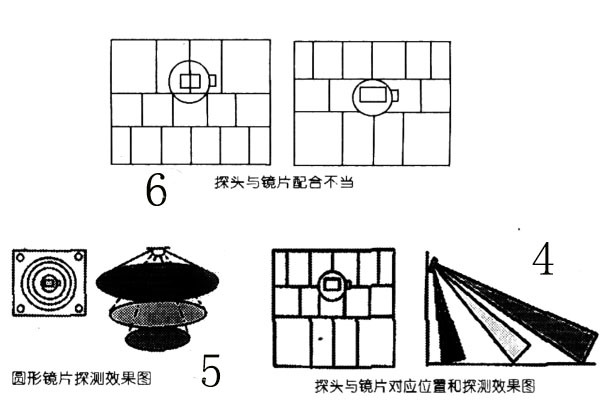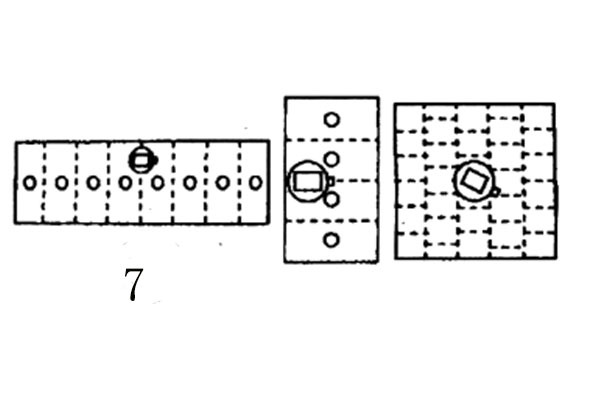Infrared sensing lens sensing method and application
Time:
2019-04-15
Infrared lens sensing
In the static case, there is infrared light in the space. Since the dual-type probe adopts complementary technology, no electrical signal output is generated. In the dynamic case, the human body is induced by the A element or by the B element, and Sa<Sb or Sa>Sb produces the difference. The binary loses the complementary balance and generates the signal output sensitively, as shown in Fig. 3G. When the person moves to the vertical state of the probe, Sa=Sb does not produce a difference, and it is difficult for the binary to generate a signal output. Therefore, it is preferable that the position where the detector is mounted is parallel to the direction in which the person walks. According to the above principle, the probe and the lens can be combined to form the following inductive body detector.
1. Single-zone multi-segment horizontal and single-zone multi-segment vertical
Figure 1 is a single-zone multi-stage horizontal type with large sensing angle. This is because the horizontal field of view of the probe is large, forming a rectangular fan-shaped sensing area. The single-zone multi-stage horizontal type is also called horizontal curtain type sensing. This sensing method can avoid Up and down infrared interference. Figure 2 is a single-zone multi-segment vertical type with a small sensing angle. This is because the vertical field of view of the probe is small, forming a vertical fan-shaped sensing area. The single-zone multi-segment vertical type is also called vertical curtain type sensing. Open left and right infrared interference. Figure 3: The probe and the lens do not meet the requirements of Sa<Sb or Sa>Sb, so the induction is not sensitive. A curtain-like sensing effect can also be achieved by using lenses with similar concentric circles. Single-zone multi-segment and dual-segment multi-segment are mostly used for local area sensing.

Multi-zone multi-section inductive and multi-zone multi-section cone
Figure 4 is a corresponding position and detection effect of the multi-zone multi-segment inductive probe and lens. The multi-zone multi-segment inductive type is mostly used for wall-mounted installation, and the three different areas are detected obliquely downward. Figure 5 is a multi-zone multi-section cone induction type, which is mostly used for ceiling mounting and direct downward detection. The dual-lens probe is equipped with a circular lens for sensing. The pattern is not like a cone. Because the horizontal angle of view of the probe is larger than the vertical angle of view and Sa=Sb appears, the cone effect diagram will be concave in the middle. If the circular lens is equipped with a four-source probe, the sensing pattern is more like a cone, as shown in Figure 5. The multi-zone multi-segment and multi-zone multi-section cone sensing area is wide and is used for large-area detection.
If the sensor is matched with the lens, if it does not meet the requirements, it will not be induced. Figure 6 The left middle lens is placed upside down. The right middle probe is placed in the middle of the lens. There is no long-distance sensing effect, and the lower blind area is enlarged.

Alternative method of detecting effects
The sensor is offset from the lens and can produce different directions and effects. The sensor is on the upper side and the detection direction is downward, as shown in Figure 7. Similarly, the sensor is biased down and the detection direction is upward. The sensor is to the left and the detection direction is to the right, as shown in Figure 7. Similarly, the sensor is to the right and the detection direction is to the left. The sensor is 45°, which reduces the movement of the human body and is limited by the direction, as shown in Figure 7. The sensor is 45° and slightly tilted for proper detection of narrow areas.

Method for enhancing the sensitivity of detecting motion
The more the number of segments is, the smaller the amplitude of the sensed human body is. Therefore, the selection of a multi-section and dense lens can enhance the sensitivity of the detection action, and the human body only needs to move slightly within the effective range of the induction. Lenses with high segment density have as many as 26 segments at 50mm length.
Method of enhancing anti-interference
The number of segments is less affected by the movement of the human body. The use of lenses with a small number of segments can reduce malfunctions. First, the human body has a large amplitude of motion, and secondly, the lens with a small number of segments forms a local detection, reducing the source of external interference.
Obviously, the above two points are a pair of contradictions, so the infrared lens can only seek a balance between the two.
Related News
Mar 18,2019
Mar 12,2019
Mar 02,2019
Facebook为混合菲涅尔透镜申请专利 这将使VR光学更加清晰
Feb 25,2019
Feb 15,2019
Jan 24,2019



